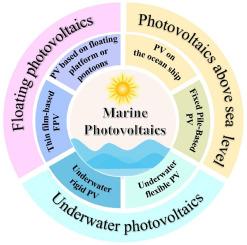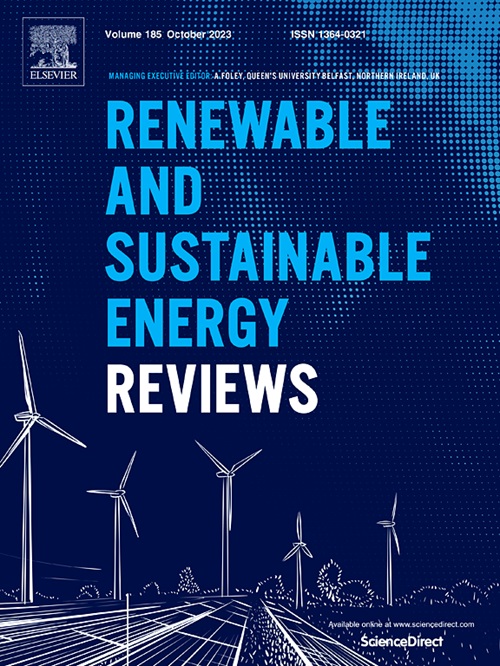Recent advances in longitudinal spatial area marine photovoltaics
IF 16.3
1区 工程技术
Q1 ENERGY & FUELS
引用次数: 0
Abstract
Photovoltaic power generation technology converts sunlight directly into electricity without any heat engine interference, offering a new solution to address the growing energy crisis and environmental pollution. However, land-based photovoltaic systems face challenges such as limited space availability, intense heating of photovoltaic cells, dust deposition, and shading effects. The focus on solar energy is gradually shifting towards the ocean. Marine photovoltaic systems can effectively overcome the limitations of land-based photovoltaics, avoiding shading, utilizing a broader space, and utilizing seawater as a cooling medium to reduce the temperature of photovoltaic systems. Currently, numerous review articles emphasize marine floating photovoltaics, yet there is a lack of commentary on marine longitudinal space photovoltaic power generation systems. Therefore, this review meticulously introduces the latest research progress in marine photovoltaic systems, encompassing floating photovoltaic systems, fixed pile foundation photovoltaic systems, photovoltaic systems applied to ocean-going vessels, and underwater photovoltaic systems. The spatial division rules of sea level, above sea surface and below sea surface are used to summarize. The work thoroughly analyzes the factors influencing the efficiency and performance of each system. Furthermore, an economic and feasibility evaluation is conducted for each system, providing a robust research foundation for the future development and application of marine photovoltaic technology.

纵向空间区域海洋光伏技术的最新进展
光伏发电技术可将太阳光直接转化为电能,不受热机干扰,为解决日益严重的能源危机和环境污染问题提供了新的解决方案。然而,陆基光伏系统面临着空间有限、光伏电池发热剧烈、灰尘沉积和遮阳效应等挑战。人们对太阳能的关注正逐渐转向海洋。海洋光伏系统可以有效克服陆基光伏的局限性,避免遮挡,利用更广阔的空间,并利用海水作为冷却介质,降低光伏系统的温度。目前,许多综述文章都强调了海洋漂浮光伏发电,但缺乏对海洋纵向空间光伏发电系统的评论。因此,本综述细致介绍了海洋光伏系统的最新研究进展,包括浮式光伏系统、固定桩基光伏系统、应用于远洋船舶的光伏系统以及水下光伏系统。采用海平面、海面以上和海面以下的空间划分规则进行归纳总结。研究深入分析了影响各系统效率和性能的因素。此外,还对每个系统进行了经济和可行性评估,为未来海洋光伏技术的开发和应用提供了坚实的研究基础。
本文章由计算机程序翻译,如有差异,请以英文原文为准。
求助全文
约1分钟内获得全文
求助全文
来源期刊

Renewable and Sustainable Energy Reviews
工程技术-能源与燃料
CiteScore
31.20
自引率
5.70%
发文量
1055
审稿时长
62 days
期刊介绍:
The mission of Renewable and Sustainable Energy Reviews is to disseminate the most compelling and pertinent critical insights in renewable and sustainable energy, fostering collaboration among the research community, private sector, and policy and decision makers. The journal aims to exchange challenges, solutions, innovative concepts, and technologies, contributing to sustainable development, the transition to a low-carbon future, and the attainment of emissions targets outlined by the United Nations Framework Convention on Climate Change.
Renewable and Sustainable Energy Reviews publishes a diverse range of content, including review papers, original research, case studies, and analyses of new technologies, all featuring a substantial review component such as critique, comparison, or analysis. Introducing a distinctive paper type, Expert Insights, the journal presents commissioned mini-reviews authored by field leaders, addressing topics of significant interest. Case studies undergo consideration only if they showcase the work's applicability to other regions or contribute valuable insights to the broader field of renewable and sustainable energy. Notably, a bibliographic or literature review lacking critical analysis is deemed unsuitable for publication.
 求助内容:
求助内容: 应助结果提醒方式:
应助结果提醒方式:


